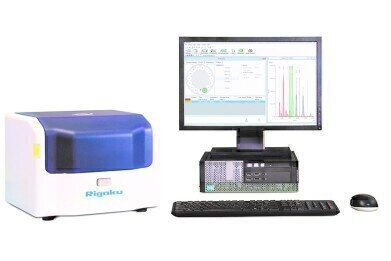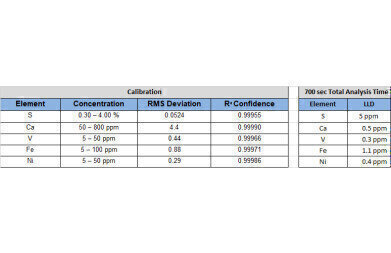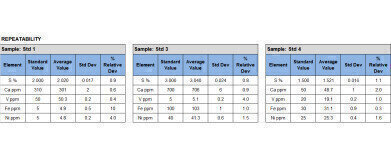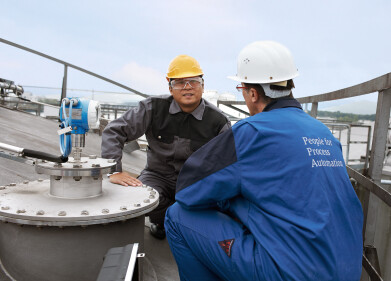-
 Rigaku NEX DE Energy Dispersive X-ray Fluorescence Spectrometer
Rigaku NEX DE Energy Dispersive X-ray Fluorescence Spectrometer -
 Calibration and Detection Limits
Calibration and Detection Limits -
 Sample Standards
Sample Standards
Analytical Instrumentation
Analysis of Sulfur and Metals in Crude by EDXRF
Oct 15 2019
Scope
The analysis of sulfur, calcium, vanadium, iron and nickel in crude is demonstrated. The measurement is also applicable to residual oil, bunker fuels and other heavy hydrocarbon oils.
The Rigaku NEX DE Energy Dispersive X-ray Fluorescence (EDXRF) elemental analyser complies with ASTM D8252-19, Standard Test Method Vanadium and Nickel in Crude and Residual Oil by X-ray Spectrometry.
NYMEX/CME specifications allow for maximum levels of 8 mg/kg Ni and 15 mg/kg V for light sweet crude oils futures contracts. NEX DE is used as a simpler, faster alternative to ICP to meet the NYMEX/CME requirements.
Background
Sulfur, vanadium and nickel occur naturally in crude oil, and their concentrations vary depending on the geographical region of the oil deposits. Depending on the region some crude may also contain measurable levels of calcium and iron. High metal content can foul the refining process during cracking, and so low metal crude is desirable. At the refinery as well as midstream at pipelines, transportation, gathering points and during blending a quick and easy means of screening and monitoring the metal content is a valuable tool in characterising the quality of the crude before refining. Rigaku NEX DE EDXRF analyser is an ideal multi-element tool for monitoring the concentrations of not only sulfur and metals in crude, resid and other heavy hydrocarbons.
Instrumentation
Model: Rigaku NEX DE
X-ray tube: 12W 60kV Ag-anode
Detector: High Throughput SDD
500,000+ cps
Sample Type: Crude
Film: 4um Polypropylene
Analysis Time: 700 sec
Optional: Single Position or Autosampler
Environment: Air
Sample Preparation
Ensure each oil sample is homogeneous and stable. Simply fill an XRF sample cup 3/4 full (4g) and measure directly.
Calibration
Empirical calibrations were built using a suite of 10 commercially available mineral oil calibration standards that represent crude, resid and other heavy hydrocarbon oils.
Repeatability
To demonstrate repeatability (precision), three calibration standards were measured in 10 repeat analyses using an analysis time of 700 sec per sample without moving the sample between measurements. Shorter measurement times can be used if such excellent precision is not required.
Detection Limits (LLD – Lower Limit of Detection)
In the empirical method, ten repeat analyses of a blank mineral oil sample are taken with the sample in static position, and the standard deviation (σ) is determined. The LLD is then defined as 3σ. Shorter measurement times can be used if such low detection limits are not required.
Conclusion
The Rigaku NEX DE spectrometer gives technical and non-technical operators alike a simple yet powerful and versatile system for quantifying multi-elemental composition using the empirical approach. The results indicate that given stable samples, proper sample handling and calibration technique, the NEX DE achieves excellent performance for monitoring sulfur and metals in crude and other heavy hydrocarbon oils.
Digital Edition
PIN 25.1 Feb/March
March 2024
In This Edition Safety - The technology behind the ION Science Tiger XT - Safety with ammonia and LOHCs as hydrogen carriers Analytical Instrumentation - Discussion on new tribology te...
View all digital editions
Events
Apr 22 2024 Hannover, Germany
Apr 22 2024 Marrakech, Morroco
Apr 22 2024 Muscat, Oman
Apr 22 2024 Rotterdam, Netherlands
Apr 23 2024 Singapore

















